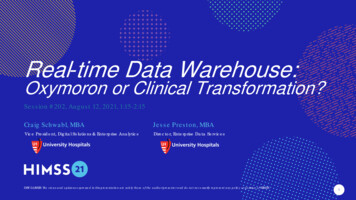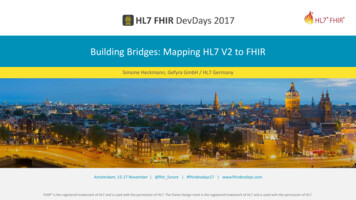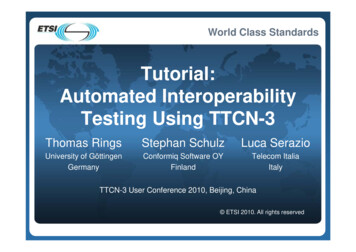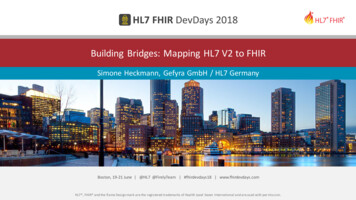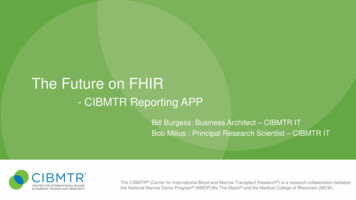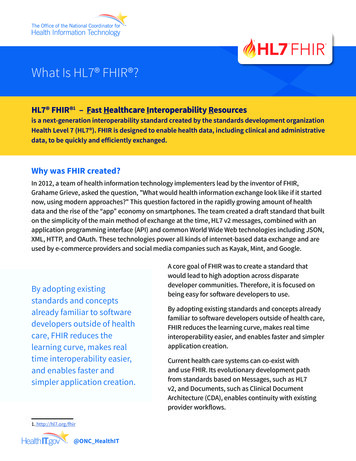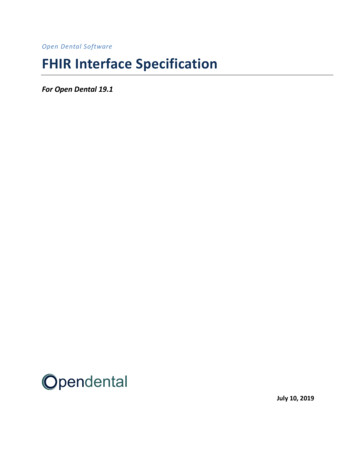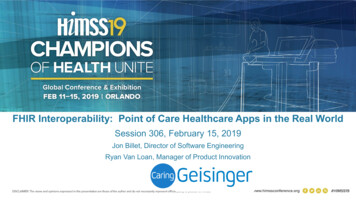
Transcription
FHIR Interoperability: Point of Care Healthcare Apps in the Real WorldSession 306, February 15, 2019Jon Billet, Director of Software EngineeringRyan Van Loan, Manager of Product Innovation1
Conflict of InterestJon Billet Have no real or apparent conflicts of interest to report.Ryan Van Loan Have no real or apparent conflicts of interest to report.2
Agenda Learning Objectives Overview Introductions Geisinger’s Approach to Innovation FHIR and its Role in Interoperability Challenges in using FHIR Technology Geisinger Use Cases Approaches to using FHIR Successfully Future Recommendations3
Learning Objectives Overview1. Describe FHIR and its role in interoperability2. Identify the potential challenges presented in developing apps usingFHIR3. Explain several Geisinger use cases utilizing FHIR4. Describe potential approaches for successful utilization of FHIR4
IntroductionsJon Billet Director of Software Engineering for Steele Institutefor Health Innovation, Geisinger Health System In his role, he is responsible for all custom softwareactivities including team direction and strategy thatsupport project and organizational initiatives. Jonserves as the internal and external key contact fordevelopment and advisory related activities theSteele Institute Software Engineering teamperforms. Prior, Jon worked as a federal governmentcontractor before entering healthcare. Dutiesincluded architecting software for the Departmentof Defense, the State Department, the GSA, theIRS, and other government agencies. Jon bringsover 15 years of experience in the softwareengineering arena.5
IntroductionsRyan Van Loan Manager of Product Innovation for SteeleInstitute for Health Innovation, GeisingerHealth System Ryan has nearly 9 years’ experienceimplementing innovation and researchthroughout Geisinger, managing theadministrative, operational, and technicalfacets of projects in the Steele Instituteportfolio– Portfolios range from clinician-facingpopulation health and point of careapplications to patient-facing 365-daysa-year, mobile applications to ArtificialIntelligence and Machine Learning Ryan has been a repeat guest lecturer atPennsylvania State University’s Master ofHealth Administration Graduate Program6
Geisinger: An Introduction A physician-led integrated health servicesorganization– Serves more than 3 million residents in 45 counties– Clinical Enterprise, Health Insurance Company,Geisinger Foundation, and GeisingerCommonwealth School of Medicine Technologically advanced– Using Epic EHR since 1998– Among “Most Wired Hospitals and Health Systems”14 years Nationally recognized– Model for high-quality and high-value integratedservice delivery– One of the largest rural health systems in the U.S.7
System Service Area8
Steele Institute for Health InnovationPurposeLead the nation in building transformative, scalable,measurable, and sustainable solutions that improve health,care delivery, patient experience, and lower costDefinition of innovationA fundamentally different approach to solving a problem thathas quantifiable outcomesGuiding principles Problem solving, value creating Advance values and strategic priorities Build upon data-backed strengths Inspired by both the broader healthcare community and otherindustries National replication potential Keep Geisinger family at the forefront9
How we will develop our third generation ofinnovationLeveraging Geisinger’sassets and accessingnew capabilities AI / machine learning Data analytics Care modelsClinical and genetic dataCulture of innovationIntegrated systemStable population to solvethe defininghealth problemsof our time10
Geisinger IncubatorCross functional approach to ProductInnovation The Product and Clinical Innovation Team is anadvanced and predictive analytics, implementation,product management, and software developmentgroup that seeks to deliver greater health care valuethrough product and process development, clinicalcare model redesign, patient-family engagement.Help clinicians and researchers generate ideasSupport innovation best practicesDevelop skills and spread innovation across the enterpriseProvide core resources to develop, design, implement & evaluate new ideasFoster and support partnerships with Research, IT and Operations11
Fast Healthcare Interoperability Resources:An Introduction to An open, standards-basedplatform for medical appsdesigned to enable connectingapps to multiple EHRs FHIR (Fast HealthcareInteroperability Resource)FHIRprovides “resources” or detailedsets of API’s, references, and“core” data models If an EHR supports FHIRresources, then an app usingFHIR is essentially EMRagnostic12Mandl KD et al Driving Innovation in Health Systems through an Apps-Based Information EconomyCell Syst. 2015 Jul; 1(1): 8–13.
Fast Healthcare Interoperability Resources:What isand its role in interoperability?LearningObjective1 An open, standards-basedplatform for medical appsdesigned to enable connectingapps to multiple EHRs FHIR (Fast HealthcareInteroperability Resource)FHIRprovides “resources” or detailedsets of API’s, references, and“core” data models If an EHR supports FHIRresources, then an app usingFHIR is essentially EMRagnostic13Mandl KD et al Driving Innovation in Health Systems through an Apps-Based Information EconomyCell Syst. 2015 Jul; 1(1): 8–13.
Fast Healthcare Interoperability Resources:What isand its role in interoperability?LearningObjective1FHIR followsan 80-20principleFHIR is oftenpaired withauthenticationprotocols toensure securityUse of FHIR inEHR-integrated,point of carehealthcare appshas beenlimited14
Challenges in using FHIR TechnologyLearningObjective2 Data accuracy and availability– Some EHR’s and companies (e.g., SMARTBoston) offer sandbox environments todevelop FHIR apps– Often these environments lack the realisticand robust data found in EHRs. Forexample, accepting free text valuesfor diagnoses.– FHIR resources may accept multiplestandard codes such as ICD-10 orSNOMED and EHR vendors mayaccept either or both15
Challenges in using FHIR TechnologyLearningObjective2 FHIR version compatibility– FHIR now has multiple versions that are allslightly different. (e.g., Cerner supports DSTU2while EPIC’s latest release supports DSTU2and STU3) Software engineering capabilities– Building clinical apps requires knowledge ofboth software development and EHR structures16
Geisinger Use CasesLearningObjective3"Geisinger's ability tocommercialize its EHR workflowsvia FHIR to a growing number ofFHIR-enabled EHR platforms ispioneering and will usher in a newera of provider and patientfocused applications to moreeffectively deliver care.“– Aneesh Chopra, former ChiefTechnology Officer, UnitedStates of America17Source: Terry, K. (2015, April 15). First Advanced App Platform for Interoperability Launched. Retrieved March 20, 2018, from https://www.medscape.com/viewarticle/843054
Geisinger Use Cases: PACERLearningObjective3 First FHIR-enabling exercise we attempted (Fall 2014-Spring 2015)18
Geisinger Use Cases: PACERLearningObjective3 Converted the apps API’s from standard EHR web services toFHIR services Limited by FHIR Resources available at the time App was able to consume data using FHIR (“pull”) but couldonly return data using FHIR in Cerner EHR (at the time) App was highly customized to our RheumatologyDepartment19
Geisinger Use Cases: Family CaregiverApplication (FCA)LearningObjective3 FCA is designed to enable family caregivers to efficiently andeffectively communicate with the care team and their dependentto coordinate care20
Geisinger Use Cases: Family Caregiver Application (FCA)LearningObjective321
Geisinger Use Cases: Family CaregiverApplication (FCA)LearningObjective3 Pivoted to EPIC’s existing FHIR resources utilizing EHR test data– Began with DSTU2, but utilized STU3 version instead (more modern, moreelements, etc.) Able to successfully FHIR-enable FCA while adhering to the 80-20 principle Approach– Evaluate existing data elements in the app to determine app vs. EHR vs.other data– Map EHR data elements to FHIR Resources– Convert data resources– Update coding to FHIR standards (e.g., SNOMED, RxNorm, LOINC, etc.)APIs, DB schema/structure, etc.– Test against EHR development environments22
Geisinger Use Cases: Family CaregiverApplication (FCA)LearningObjective3 FHIR Resources Used– Patient, Related Person, Encounter, Practitioner, Care Plan, Care Team,Location, and Medication (including Statement and Order) Resources– Over 45 FHIR data elements within identified FHIR Resources utilizedthroughout the application23
Geisinger Use Cases: MedTrueTMLearningObjective3 MedTrueTM is an EHR-integrated workflow solution thataggregates multiple data sources to enhance the medicationreconciliation process and uncover patient issues withmedication adherence24
Geisinger Use Cases: MedTrueTMLearningObjective3 We’re currently moving through the process of FHIR-enabling MedTrueTM Approach– Evaluate existing data elements in the app to determine app vs. EHR vs.other data– Map EHR data elements to FHIR Resources Challenges encountered– MedTrueTM utilizes many custom data sources in its current version thatallow physicians to review patient-reported and nurse-verified med listsand push them into the EHR, updating the patient’s medication list withintheir chart– FHIR has write-back Resources available but EHRs do not support manyof these services beyond documentation– Additionally, many EHRs do not support standard web services to writeback– Currently exploring potential options to mitigate this25
Approaches for using FHIR successfullyLearningObjective4 Any approach to FHIR requires access to existing EHR’s as a source oftruth when developing FHIR apps– Limited apps may be able to utilize sandbox environments, but any robustdata services A systematic approach, similar to the one we used for FCA and MedTruecould be adopted by other software engineers and systems looking todevelop FHIR-based appsEvaluateConvertTestMapUpdate26
Future Recommendations We all should look to what we’ve learned in standardizing EHR’s andapply those learnings to FHIR EHR’s interested in 3rd party app development should provide morerobust, realistic, and well-supported sandbox environments– This would allow companies and software engineers outside ofhealthcare to develop apps ready for the real world EHR’s need to expand their FHIR resources beyond merely ‘read’ andopen up ‘write back’ resources Healthcare systems should come together to call for universal adoptionof FHIR standards– Agreed upon release dates of new versions– FHIR implementations that are more closely related27
Questions28
Contact InformationJon BilletDirector of Software EngineeringEmail: jabillet@geisinger.eduRyan Van LoanManager of Product InnovationEmail: rpvanloan@geisinger.eduPlease remember to complete your online session evaluation for our session29
commercialize its EHR workflows via FHIR to a growing number of FHIR-enabled EHR platforms is pioneering and will usher in a new era of provider and patient-focused applications to more effectively deliver care." -Aneesh Chopra, former Chief Technology Officer, United States of America Source: Terry, K. (2015, April 15).

